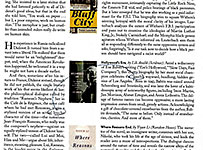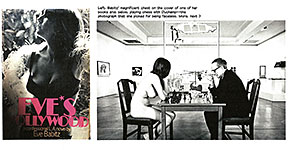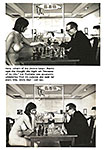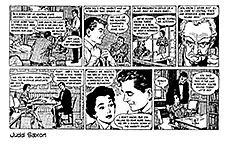 |
|||||||
Opus 391 (April 13, 2019). Mostly editoons in this posting, plus a list of all the nominees for awards from the National Cartoonists Society, but there’s more, a little more. Here’s what’s here, in order, by department—:
NOUS R US Benson Finds New Arizona Home Wiley Takes Responsibility: A Parable
NOMINEES FOR NCS AWARDS History of the Reuben Trophy Reuben Nominees Rube Nominees
Trumperies EDITOONERY A Selection from the Last Month Plus a Few Paragraphs about Dilettante Congress
THE FROTH ESTATE Louche A Chest Game NEWSPAPER COMICS PAGE VIGIL Sampling Notable Achievements
PASSING THROUGH Ken Bald
QUOTE OF THE MONTH If Not of A Lifetime “Goddamn it, you’ve got to be kind.”—Kurt Vonnegut
Our Motto: It takes all kinds. Live and let live. Wear glasses if you need ’em.
But it’s hard to live by this axiom in the Age of Tea Baggers, so we’ve added another motto: Seven days without comics makes one weak. (You can’t have too many mottos.)
And in the same spirit, here’s—: Chatter matters, so let’s keep talking about comics.
And our customary reminder: don’t forget to activate the “Bathroom Button” by clicking on the “print friendly version” so you can print off a copy of just this installment for reading later, at your leisure while enthroned. Without further adieu, then, here we go—:
NOUS R US Some of All the News That Gives Us Fits
BENSON FINDS A NEW ARIZONA HOME Editoonist Steve Benson, who, with a number of other journalists, was dismissed in January from the Arizona Republic in another of the industry’s short-sighted cost-cutting maneuvers, has continued cartooning through his syndicate, Creators. His subjects were national rather than local politics, and his Arizona readers missed his not-so-gentle touch on Arizona issues. But not for long. In early April, the Pulitzer-winning editoonist again began poking his pen at local politics, joining the staff of the Arizona Mirror, an independent, nonprofit, online news organization covering Arizona government, policy, and politics, saith D.D. Degg at dailycartoonist.com. The organization launched in September 2018. Benson is doing two cartoons a week, on Tuesdays and Fridays. AzMirror.com features in-depth news stories, a journalist-driven blog, progressive commentary on Arizona issues and more. “A strong, free press is essential for a strong democracy, and we wholeheartedly believe that providing news about Arizona government, and the policies it enacts that directly affect the lives of people who live in this great state, is a vital community service,” said Arizona Mirror Editor-in-Chief Jim Small. “That belief that an informed Arizona is a better Arizona is why we will have no paywalls and no subscription fees.” Small rejoiced at Benson’s arrival on staff: “I
couldn’t be more excited for this new phase in my fledgling outfit’s growth. In
the short six months since we launched a nonprofit news organization, our small
team has done some fantastic journalism. We’ve broken stories on a state
official and her top aides apparently deleting their “Adding Benson to the mix gives the Mirror an entirely new arena for journalism and commentary. And it’s not every day you get to add a Pulitzer Prize winner to your team. Arizona needs his voice, and we are ecstatic to be able to bring it to readers across our great state.” Dunno if the cartooning gig pays much (or at all). My guess is that most of the staff are working voluntarily for very little recompense. (And the absence of paywall and subscription fees supports that guess.) But it’s gratifying to know Benson’s able to skewer Arizona politics again. For an example of how he attacks national political ills, see Editoonery down the scroll.
WILEY TAKES RESPONSIBILITY: A PARABLE The worst is over, apparently. In the wake of Wiley Miller’s gaffe with a vulgarity in the Sunday Non Sequitur strip for February 10 (see Opus 388b and 390), the cancellations by client papers, which surged on for a week or more, have completely stopped. In fact, John Glenn at Wiley’s syndicate, Andews McMeel, tells me, “We’ve actually seen 6 clients come back after initially cancelling and one new sale responding who liked the Easter egg.” (The “Easter egg” was Wiley’s initial but misguided way of alluding humorously to the profanity hidden in the strip.) Those who have returned are clearly returning to their senses. What self-respecting 21st century American newspaper editor drops a comic strip with a 27-year record of admirable behavior over one mistake? Phooey. But bravo to those who’ve returned. But Wiley didn’t finish addressing the matter until the week of April 3-6, when he took his New England character, Captain Eddie, out to sea, where he was caught in a storm and his boat wrecked (as illustrated in the preceding visual aid). Captain Eddie took full responsibility for the mistake he made in going to sea with a storm on the horizon. He vows to reinvent himself and carry on. He knows it’ll take a long time to come back, and that things will never be the same. But he’ll be a wiser and better person for enduring the ordeal. It looks to me as if Captain Eddie’s adventure was shaped by Wiley’s misadventure, and this week’s strips are a parable, the cartoonist’s way of taking responsibility for his error and apologizing too. Daily strips are usually produced about 4-5 weeks in advance of publication, which, in this case, would have been about a month after the fallout from the Sunday strip began. A workable timetable.
FURTHER ADO A few thoughts on “beauty” from Jon W.’s Curmudeon—: I’m tired of all this nonsense about beauty being only skin-deep. That’s deep enough. What do you want, an adorable pancreas?—Jean Kerr I’m so ugly, as a kid I once stuck my head out the window and got arrested for mooning.—Rodney Dangerfield Looks count! Forget “inner beauty.” If a man wants inner beauty, he’ll take X-rays.—Joan Rivers A woman wants to be pretty rather than intelligent because men generally see better than they think.—Jewish Proverb I will never understand how women can take boiling hot wax, pour it onto their upper thighs, rip hair out by the root, and still be afraid of a spider.—Jerry Seinfeld
NOMINEES FOR NCS AWARDS History of the Reuben Trophy IT’S THE AWARD SEASON once again. The spring of the year is littered with awards given to cartoonists. We’ve had the Herblock Prize (which went to Matt Davies —his second win for this trophy; see Opus 390), and the Pulitzer isn’t far off. Every year since 1946, the National Cartoonists Society (NCS) has named one of the inky-fingered affiliation ”Cartoonist of the Year” and given that pedestaled individual a trophy in recognition of his/her achievement. At first, the award was named the Billy DeBeck Award after the cartoonist who created Barney Google, and the recipient received a silver cigarette box, its lid engraved with pictures of the characters in DeBeck’s comic strip. DeBeck’s widow, Mary, had instituted the award and specified that it be named after her celebrated husband, who died in 1942. Caniff told me once that as far as he knew, she picked the winners, unaided by any NCS committee or mechanism. When she died in 1953, the Billy DeBeck Award expired with her but the Cartoonist of the Year tradition continued, albeit with a trophy of a different name (and an official selection process). The award was henceforth called the Reuben in honor of the Society’s first president and nominal convener of the founding meeting in 1946, Rube Goldberg, a cartoonist whose name alone was destined to evoke an image of “cartoons.” Born
in 1883, Goldberg began his storied career in 1905 when he went to work in the
art department of the the San Francisco Chronicle. Like most cartoonists in the
first decades of the century, Goldberg drew several cartoons a week; all were
titled but some lasted only a day or so. Among Goldberg’s more enduring creations
in this mode were Mike and Ike (They Look Alike), What Are You Gonna Do with
it ?, They All Look Good When They’re Far Away, Lunatics I Have Met, I’m the
Guy (That Put the Bar in Bombardment), Father Was Right, What Are You Kicking
About, Telephonies, The Weekly Meeting of the Tuesday Women's
Club, and a couple dozen more, many produced simultaneously. One of them, Foolish
Questions, was a hit and continued for decades. (“Why, hello, Jones—are you
still in town?” “No—I’m touring Europe in a wheelbarrow.”) But the cartoon that made Goldberg famous debuted November 10, 1914 without a title. Goldberg would do one of this series every two weeks until 1934. (Once a month until 1964.) Each one was a schematic drawing depicting a complicated array of gadgetry performing some simple task in indirect, convoluted ways. The cartoons led to the expression "Rube Goldberg machines" to describe similar gadgets and processes, and "Rube Goldberg" eventually appeared in dictionaries meaning “having a fantastically complicated improvised appearance” of “deviously complex and impractical.” Finally, Goldberg gave the cartoon a title, The Inventions of Lucifer G. Butts, A.K. Goldberg also wrote columns and short stories for magazines, and in 1916, he created a series of animated short films about humorous aspects of daily life. And he continued his other cartooning and writing efforts at the same time. In 1915, he began doing cartoons about a “fall guy” named Boob McNutt, a clumsy, buffoonish albeit friendly fellow who tried to help but inevitably failed disastrously when entrusted with tasks at which he would prove hopelessly incompetent. Boob McNutt was syndicated as a Sunday strip beginning June 9, 1918; in 1924, a daily version began. The whole seven-days a week project continued until September 30, 1934. In about 1937, Goldberg took a year off, and when he returned in 1938, he did editorial cartoons for the New York Sun, which he continued, winning a Pulitzer in 1948, until 1964, when he quit to devote his time to sculpture, his last career.
NCS’s Reuben trophy is pure Goldberg. In fact, it was initially cast from a sculpture that Rube himself made. A whimsical creation by the man who had made his name synonymous with outlandish inventions, it consists of a comical pile of male nudes, traditional cartoony characters who had attempted, apparently, to form a human pyramid and had enjoyed some success in the attempt— as much success, that is, as any Goldberg invention ever achieved. The sculptor explained his creation as follows (in italics)—: If you have been influenced by Freud you might say that the Reuben represents four cartoonists who hated their mothers for allowing them to become cartoonists and [who grope] for an acrobatic answer to the question of why sculptors and pretzel makers have so much in common. Or you might say that the Reuben represents the people of the world striving for a perfect balance to escape the same fate as the leaning tower of Pisa. You'd be wrong on both counts. The Reuben is pure fantasy, including the bottle of India ink that Bill Crawford placed on the posterior of the top man to give the design a little more symmetry. If the Reuben has an underlying significance in its present form, I will say that I created it to keep it from looking like a golf trophy, an Oscar, or a statuette presented to Miss Kitchen Utensils of 1953. My only hope is that each recipient will look upon it as a symbol of the admiration and love of his fellow cartoonists. Goldberg's explanation was, of course, another of his outlandish inventions. He didn't create the sculpture to serve as the NCS award: when he made it, he thought he was making a lamp, the light bulb screwed into the aforementioned posterior of the uppermost figure. Happily, fellow cartoonist Bill Crawford saw this objet d'art in Rube's home at just about the time the Society was looking for a trophy for the Reuben, and he recognized at once that Goldberg's lamp was destined for greater things. He made a cast of it for the trophy and substituted a bottle of ink for the light bulb. The first to receive the Reuben in all its glory, trophy and fanfare, was the sports cartoonist Willard Mullin, who was named Cartoonist of the Year in 1954. (The eight cartoonists who had won the Billy DeBeck Award for the years 1946-1953 were subsequently presented with Reuben statuettes and are termed Reuben winners in the annals of the Society.) Tales of the origin of the Reuben have always assumed that the lamp that was appropriated for the award had been sculpted by Goldberg during his last “career” as a sculptor. But, as it turns out, that isn’t true, as any self-respecting researcher could have determined. Goldberg’s biographer, Peter C. Marzio (in Rube Goldberg: His Life and Work), says with admirable precision that Goldberg’s sculpting career began January 7, 1963—ten years after the Reuben trophy had been devised. It
wasn’t until I was paging through another tome, Chuck Thorndike’s antique
booklet The Business of Cartooning, that dates assumed a more Goldberg’s drawing of the Reuben trophy is at the left of the images nearby. The image to the right of Goldberg’s drawing appears in Thorndike’s booklet at the Rube Goldberg entry. The caricature of Goldberg was, Thorndike indicates, “made-from-memory” which doubtless excuses it for not looking much like Goldberg. To the left of that sketch of Goldberg is another made-from-memory sketch, this time, of the legendary lamp. Thorndike’s book was published in 1939. So the lamp existed long before it served as a model for the Reuben in 1953. Goldberg was sculpting in the 1930s, rehearsing, no doubt, for that third (and final) career. The last image in the accompanying visual aid is a better caricature of Goldberg than Thorndike’s made-from-memory sketch; it’s by Karl Hubenthal, who used it in an editorial cartoon bidding farewell to Goldberg, who died December 7, 1970. Before he died, Goldberg was awarded his very own Reuben as Cartoonist of the Year, in 1967. It was for “humor in sculpture.”
2019 Reuben Nominees WHEN I FIRST HEARD of the existence of the National Cartoonists Society—in about 1958, while a junior in college—I was desperate to belong. The faculty sponsor of the campus magazine I was editing was a member, and he told me about NCS. How he became a member, I don’t know: he wasn’t a cartoonist, but he’d become a member under some ruse or another. I finally became a member in the early 1980s. By then, I had acquired two of the essential credentials for membership: I was cartooning professionally (since 1978, I’d been selling gag cartoons to magazines; I didn’t make my living at it, but as a moonlighting cartoonist, I qualified for associate membership); and I knew someone who could recommend me for membership— Milton Caniff, one of the founders of NCS, whose biography I was working on. His letter recommending me for membership also recommended Mike Peters. The letter was only a paragraph long; no notes about our separate qualifications, just “make these two guys members” (or words to that effect). That is a gauge of the clout of a founding member of the club. Although I’ve always been proud of being a member, I’ve also, over the years, acquired a few pet peeves about the Society. The first of these minor annoyances arose in connection with the Reuben Award. It is given to the person whom NCS names “Best Cartoonist of the Year.” And the first winner was, indeed, the “best” of the year: it was Caniff, who had just launched his second syndicated comic strip, Steve Canyon, and in doing so, he had achieved something almost none of his fellow syndicated cartoonists had achieved—ownership of his feature. Most syndicated comics are owned by the distributing syndicate. So Caniff was doubtless the “best” that year because he exemplified (and personified) a goal all cartoonist aspired to. He was also a damn fine cartoonist, whose practice of his craft turned it into an arform. And that didn’t hurt his chances for winning the award. But for winners since then, I’ve had a hard time accepting that the Reuben winner was the “best” cartoonist of the year. I think NCS would be more accurate about the winner of its premier award if he or she were termed merely “Cartoonist of the Year.” There’s no loss in dignity with that title. And that title avoids the impossibility inherent in naming someone the “best” in any given year. That nomenclature suggests that the winner has done something in that year which was startlingly different or better than he/she’d done any other year. And except for Caniff, none of the winners have done anything particularly superior in the year for which they won the award. So when reporting the winner every year, I say it’s for “Cartoonist of the Year.” My other beef about the Reuben is that it almost always goes to a syndicated cartoonist. Cartoonists who work in other venues—magazine cartooning, animation, advertising, etc.—are almost never nominated and therefore almost never win. And syndicated editorial cartoonists were ignored until Herb Block won the Reuben in 1956. “Usually” doesn’t mean “always.” In 1954, the award went to a sports cartoonist, Willard Mullin. And in 1960, it went to Ronald Searle, who was neither syndicated nor a comic strip cartoonist. The most notable exception to the “usual” is the editorial cartooning category. Several editoonists have won over the years. And endeavors in other venues have won more often in the last 10-20 years. Last year, the Reuben went to Glenn Keane, the first time it’s ever gone to a cartoonist in animation. But usually, the winner is a syndicated comic strip cartoonist. And it wasn’t until 1985 that a woman won the Reuben— Lynn Johnston— for her syndicated comic strip, For Better or For Worse. This year is no different from most years. Of the five nominees for the Reuben, four are syndicated comic strip cartoonists (but two are women!). And here they are—:
LYNDA
BARRY is a
cartoonist and writer who made her cartooning chops by producing a weekly comic
strip for alternative newspapers, Ernie Pook's Comeek. She garnered
additional attention with her 1988 illustrated novel The Good Times are
Killing Me, about an interracial friendship between two young girls, which
was adapted into a play. Her second illustrated novel, Cruddy, first
appeared in 1999. Three years later she published One! Hundred! Demons!, a
graphic novel she terms "autobifictionalography.” What It Is (2008)
is a graphic novel that is part memoir, part collage and part workbook, in which
Barry instructs her readers in methods to open up their own creativity; it won
the comics industry's 2009 Eisner Award for Best Reality-Based Work. Altogether, she’s authored 21 books. In recognition of her contributions to the comic art form, Comics Alliance listed Barry as one of twelve women cartoonists deserving of lifetime achievement recognition, and she’s won a heap of awards in various venues—including the Milt Caniff Lifetime Achievement Award from NCS, two Will Eisner Awards, and the American Library Association’s Alex Award, and she was inducted into the Will Eisner Hall of Fame in 2016. Holding an Honorary Doctor of Fine Arts degree from University of the Arts, Philadelphia, she’s currently Associate Professor of Interdisciplinary Creativity and Director of The Image Lab at the University of Wisconsin-Madison were she teaches writing and picture-making. In addition to writing and teaching, Barry does goofy stand-up comedy in the guise of instructional cartooning. You can follow Lynda on Twitter at @NearSightedMonkey.
STEPHAN
PASTIS is
the creator of the daily comic strip Pearls Before Swine, syndicated by
Universal Uclick. Stephan practiced law in the San
HILARY
PRICE is
the creator of Rhymes With Orange, a daily newspaper comic strip
distributed by King Features Syndicate. Created in 1995,
MARK
TATULLI is
an internationally syndicated cartoonist, best known for his popular comic
strips Heart of the City and Lio, which appear in 400 Mark has now expanded his cartooning and writing into middle-grade kids’ books, making the illustrated novel series Desmond Pucket for Andrews McMeel Publishing. He also wrote and illustrated two picture books, Daydreaming and They Came, for Roaring Brook Press, a Macmillan company. He is the author of two graphic novels for Little, Brown Books for Young Readers. The first, Short and Skinny, a memoir of Mark’s life in the summer of 1977 is out now.
BRIAN
BASSET is
the only one of this year’s nominees who was not nominated (but didn’t win)
last year. As a comic strip artist, Basset is best known During this time, Basset also developed the nationally syndicated comic strip Adam, later known as Adam @ Home, about a husband and father who works at home (via computer) while his wife holds down an out-of-the-house job. While producing this strip, he launched a second one in 2000, Red and Rover, which he continues to write and draw for Andrews McMeel Syndication. He gave up Adam completely, to its current author, Rob Harrell. Basset no longer has anything to do with it. Red and Rover has been nominated three times for Best Newspaper Comic Strip by the NCS, and won the award in 2013. Brian lives in Seattle Washington with his wife, Bobbi Robinson.
The Rubes of NCS IN ADDITION TO CARTOONIST OF THE YEAR, the Society gives out awards to cartoonists who labor in the various vineyards of the cartooning landscape. For a long time, these awards were called Division Awards, separating them from the Reuben Award, which goes to the Cartoonist of the Year. Newspaper comic strip division, magazine gag cartoon division, etc. But everyone called the Division Awards “Reubens” even though they weren’t Reubens; the only Reuben there is goes to, as I said, Cartoonist of the Year. In an effort to remove this confusion, a couple years ago, the NCS management decided to call the Division Awards “Silver Reubens.” That, of course—as I remarked at the time—was pure delusional bureaucratic unthink. The grand old Reuben is a bronze trophy. So the lesser of the Society’s awards, the erstwhile Division Awards, were given a metallic worth greater than the metallic worth of the grand old Reuben. Others no doubt pointed out this idiotically unintentional but insulting demotion of the organization’s premier award, and this year, the Silver Reubens have disappeared. The erstwhile Division Awards are now called “Divisional Awards,” the added “al” suffix presumably will solve the problem. But my guess is that people will still call the Divisional Awards, “al” or not, “Reubens.” My solution, brilliant though it is, has never been officially offered. But since everyone calls the Divisional Awards Reubens, why not simply hitch-hike onto that already established custom: call the Divisional Awards “Rubes.” That would eliminate all the confusion, continue by formalizing (and changing slightly) the existing practice, and also perpetuate the name by which the man after whom the Reuben is named was known by everyone. Rube Goldberg. Anyhow, just as I persist in ignoring the “Best” in the “Best Cartoonist of the Year” and shorten it to a more apt and accurate Cartoonist of the Year, I now persist in the custom I have just concocted. Here are the nominees for the Rube Award, the “Rubes,” listed by the category of cartooning endeavor each recognizes (my snide remarks in italics)—:
Editorial Cartoons —Clay Bennett, Michael Ramirez, Rob Rogers; nice—Rogers, who lost his job last year in a conflict of interest with his publisher after 25 years (see Opus 381), might get the formal recognition that will rub his former employer’s nose in it Magazine/Newspaper Illustration —Tom Bunk, Amy Kurzweil, Jim Woodring Feature Animation —Shiyoon Kim (character design) Peter Ramsay (director), Justin K. Thompson (production design); all three for “Spider-Man into the Spider-Verse” Television Animation —“Castlevania” (Netflix), “Hilda” (Netflix), “Adventures of Rocky and Bullwinkle” (Amazon Prime) Newspaper Panel Cartoons —Dave Blazek, Loose Parts; Mark Parisi, Off the Mark; Jerry Van Amerongen, Ballard Street; again, nice—Amerongen just retired, and if he wins this, it’ll be his second so he’ll be going out in style Magazine Gag Cartoons —Joe Dator, Pia Guserra, Amy Hwang; all three, mostly in The New Yorker (where else? Well, there are some small trade journals, and some obscure cartoonists are still drawing and selling to such outlets) Advertising/Product Illustration —James Lyle, Luke McGarry, Johnny Sampson; Luke McGarry is the son of Steve McGarry, past prez of NCS and current prez of the NCS Foundation and of the NCSfest, this year’s Reubens weekend, an elaborate street fair celebration of cartooning at Huntington Beach, California Comic Books —Daniel Acuna, Black Panther; John Allison, Giant Days; Greg Smallwood, Vampironia; as usual, NCS overlooks most newssstand funnybooks, apparently in the mistaken belief that only off-beat efforts are worthy of an award—phooey Graphic Novels —Rick Geary, Chester & Grace: The Adirondack Murder; Peter Kuper, Kafkaesque; Brenna Thummler, Sheets; great—Geary and Kuper getting recognition at last Online Comics, Long Form —Vince Dorse, Untold Tales of Bigfoot; Tom Parkinson-Morgan, Kill Six Billion Demons; Ota Yuko and Ananth Hirsh, Barbarous Online Comics, Short Form —Dorothy Gambrell, Cat and Girl; Lonnie Millssap, Bacon; Zack Weinersmith, Saturday Morning Breakfast Cereal Book Illustration —Genevieve Godbout, Mary Poppins; Ed Kaban, Even Superheroes Make Mistakes; Rafael Lopez, The Day You Begin Online Animation —One of the new “divisionals,” this category didn’t receive enough qualifying submissions so there are no nominees; we’ll try again next year with better description of the division To see samples of the nominees’ work, visit reubens.org, the NCS website.
QUOTES & MOTS From the Denver Post: Overall, 69 percent of Americans think gun laws should be made stricter. That’s up from 61 percent who said the same in October 2016 and 55 percent when the Associated Press first asked the question in October 2013. Overall, 90 percent of Democrats, 54 percent of gun owners, and 50 percent of Republicons now favor stricter gun control laws. Congress has barred the Center for Disease Control from researching gun violence for more than 20 years, but the latest spending bill passed in March has an addendum that “nudges” the agency back toward that kind of work, the Post reports. While it notes that CDC and other agencies are still prohibited from using funds to “advocate or promote gun control,” it also observes that “the Secretary of Health and Human Services has stated (that) the CDC has the authority to conduct research on the causes of gun violence.”
TRUMPERIES The Idiotic and Asinine but Entertaining Antics of Our Acting Prez IN ORDER TO AVOID cluttering up our Editoonery Department with pictures depicting the never-exhausted goofiness of our twitterpated chief clown, we invented this department as a sort of time-out detour. The editoons herein are all good editorial cartoons, but their function is not as serious as those in Editoonery where we display and analyze the arts of editorial cartooning as deliberate political commentary meant to remedy the world of its bad politics; here, we’re just having fun at the expense of the delusional barstool bloviator—as are most of the editoonists whose work is on display in this department. The wheels started falling off the Trumpet wagon last December, when he precipitated a partial government shutdown that lasted 35 days. The self-destruction continued this month when the GOP-controlled Senate resolved to withdraw support for the Saudi Arabian assault on Yemen, a maneuver seconded by the House. Next Congress rebuked his declaration of an emergency that he invented in order to justify his grab of funding for the Wall by robbing other appropriations in defiance of the Constitution, which gives the power of the purse to Congress. The Mueller Report, seemingly clearing Trump of any crimes, has dropped with little consequence. But New York state is investigating as is the U.S. Attorney General of the Southern District of New York. The Democrat House is holding hearings on the vast array of Trump crimes and misdemeanors, and members of the Trump clan are also being investigated by various agencies. It’s clear that the Trumpet’s power is fading. His power is based on fear, and he now senses that those who feared him a year ago are no longer afraid. A narcissistic bully of whom no one is any longer afraid will lash out in every direction as a way of reasserting his dominance. On or about March 17-20, Trump unleashed his frustrated fury against the only target that couldn’t object: he revived his assault on John McCain. Dead men can’t fight back. It was a mad man’s deranged display of despicable pique. Anderson Cooper was so enraged that he spent almost his entire “360" hour on March 20 criticizing the Trumpet’s borish bad behavior. He showed clips of speeches Trump was making, attacking McCain and then George Conway, the husband of one of his chief advisors, KellyAnn Conway, who Trump said was an unfit husband and “a whack job.” Conway’s sin? He’d been tweeting that Trump was nutso. (Or, more precisely, he tweeted the medical definition of narcissistic personality disorder and antisocial personality—and it fit the Trumpet to a, er, T.) The Mueller Report has resulted in only a temporary reprieve for the Trumpet. Beset, now, with a host of other investigations, he will feel increasingly isolated and victimized. And he will lash out some more, spewing lies and bile—as he did a few days ago in accusing Bronco Bama of instituting the ugliest of Trump policies, family separation at the border. A wholly laughable lie, easily disproved—but Trump, his ego sensibilities abused, raved on, repeating the charge over and over. And he’ll make more mistakes. Like assaulting Obamacare again. Trump couldn’t get it killed even when the Republicons held both the House and the Senate, so why does he think he can get it done now? Because he’s going around Congress into the judicial system to get Obamacare declared unConstitutional. Bad idea. And when enough of Trump’s hangers-on told him it was a bad idea, he completely reversed himself and said he was postponing the Obamacare assault until after he’s re-elected in 2020. It’s only a matter of time now. Trump’s insanity will be increasingly exhibited. The House won’t need to impeach him: his cabinet will declare him mentally unfit for the job and throw him out of the White House. Like I said, it’s only a matter of time now. But to help us pass that time, herewith are some of the more provocative images of the Trumpet from the last month.
And why is Trump so predictably, unreasonably, hostile to Obama, who is not now and never has been, any threat to him? Simple. Because Obama proved Trump wrong. Not once, but twice. First, Obama proved he wasn’t born in Kenya, despite the Trumpet’s claim to the contrary. Second, Obama proved to be a more than capable Prez, something no racist wants to believe—that a black person is actually NOT inferior.
TRUMP’S
BEHAVIOR IS SO OUTLANDISH that Time magazine has often made him the
subject of a political-cartoonery cover, as we see hereabouts at the upper left
and upper right of the exhibit—the first, on March 23, when speculation that
the Democrat-controlled House would impeach him (a charming visual pun
involving an orange fruit); the second, two weeks later, with the Trumpet
walking in a rain storm (the Mueller investigation and others?) but he’s
protected by the umbrella of the Presidency: as long as he’s Prez, he won’t get
wet. That is, he can’t be indicted. Or so they say. (“They” being an obscure Department of Justice factotum, not a recognized expert on Constitutional matters, who was actually addressing the question of whether Spirou Agnew, then Vice Prez, could be indicted.) Alas, the falling rain isn’t much evident in this scan; just imagine it. The rest of this display consists of several of my favorite photos of the Prez. In almost all photographs of him, the Trumpet has his mouth open. But the best resemblances also show his ever-active hand gestures, flailing about in search of meaning. In
the next visual aid, we’re back to editoons, beginning with one of my favorite Pat
Bagley efforts. Next around the clock is another spanking image that I ran across in one of the monthly tabloids of editorial cartoons; dunno the cartoonist, but I like the drawing. Given the size of the blonde’s chest, she’s clearly intended to be Stormy Daniels. Next to that is another Bagley effort, this time reminding us of Trump’s boarding Air Force One with a streamer of toilet paper attached to his heel. Here, the tell-tale tissue is emblazoned with the white supremacists’ support of the Prez—just so we don’t forget. And it should be as embarrassing as the earlier image. But to Trump, probably it isn’t. At the lower right, Rob Rogers shows us Trump amid the wreckage of the federal government that he’s caused, which, now, ironically, he proposes to fix himself—after he’s wrecked it. Finally, another anonymously rendered picture of just how ridiculous Trump can appear when he’s trying to attract the attention of a particular audience. I can’t recall (if I ever knew) the occasion that prompted this effort. Did Trump want Rolling Stone to interview him and put him on the magazine’s cover in a vain (both senses) attempt to attract the Youth Vote of the 1960s? Or is the magazine reference just standing for whatever publicity Trump craves at the moment? Dunno. But it’s a great drawing even if I can’t read the cartoonist’s signature. And it happily reveals that Trump will do anything, whatever it takes, for publicity that pumps his vast delusional ego. On
our next exhibit, Clay Bennett employs the familiar Spy vs. Spy cartoon
images to show how Trump’s scorn of intelligence agencies undercuts their
effectiveness. The Spy vs. Spy metaphor represents the Trumpet’s opinion
of U.S. intelligence services. In
the final display of asinine idiocy—that is, trumperies— Clay Jones starts
us off with his usual hilarious portrait of the Trumpet, this time enraged over
the disposition of the Nobel Prize, which, ironically, didn’t go to Trump (in
this cartoon) but did go to his foremost impersonator. Due to some reporter’s due diligence, we know that Trump spends more than half his day in “executive time,” doing unspecified things—mostly, we guess, watching tv and tweeting obnoxious messages to a waiting world. Across the bottom of the exhibit at hand, Chris Britt and Rob Rogers offer differing images of what Trump’s executive time might consist of. Britt shows us a self-indulgent personality surrounded by the mess of his own litter. Rogers resorts to the image of a Mickey Mouse watch with Trump as the famous rodent, the hours of executive time divided between tweeting and watching Fox News. And with that imagery, we leave the Trumperies for the nonce and proceed, ipso facto, to the serious stuff being committed in the nation’s editorial cartoons.
EDITOONERY The Mock in Democracy OUR PURPOSE HERE is not so much to “explain” the humor in a selection of editoons. As the wise man once said, explaining how comedy works is much like dissecting a frog: the result in both instances is the death of the subject. We don’t want to kill off anything here. Instead, we seek to enhance appreciation of editorial cartooning by drawing attention to the mechanisms at work in various examples. The comedy part, however, we leave alone. Our method also often shows how the same topic is dealt with by different editoonists, a desirable effort in itself for enhancing our enjoyment. (Or so we suppose.) Because the Trumpet manages to get himself in the headlines on the front pages of the nation’s newspapers almost every day with some affront to governmental order or international decorum, he figures in most of the news (and the political cartoons) of the month. The
Mueller Report was the biggest “news” of the last couple weeks, and although we
touched on the subject last time, it persists, and so we must touch it some
more this time, however leery of it we may be. And William Barr’s enthusiasm was evident before he was appointed. Prior to being appointed, Barr had written an unsolicited memo arguing that the President could not be accused of obstruction of justice. Dunno the rationale but it was probably along the lines of “since the Prez is the nation’s chief law enforcement officer and policy maker, his actions constitute establishing policy.” So while other mortals might commit obstruction of justice, when the Prez does it, it’s just setting policy. Streeter always includes a tiny image of himself in artist’s gown and beret as part of his signature—like Pat Oliphant’s penguin. Next around the clock, Steve Breen offers an ingenious visual interpretation of William Barr’s “redacted” version of the Mueller Report. We see through the blacked-out passages of the Report another image—that of the Trumpet himself, sticking his tongue out at us. Jim Margulies moves on, passed the Mueller Report jungle to what’s next on the calendar of Trumpet adventures—namely, a couple of the other pending investigations that threaten like crocodiles’ jaws in the swamp next to the forest Trump has just escaped from. And at the lower left, Pat Bagley thoughtfully assembles a partial list of what threatens the Trumpet next, the topics of the pending investigations clustered like storm clouds around a tiny Trump image. But Trump seems blissfully ignorant of these threats, choosing, instead, to dwell on the only part of the Mueller Report he endorses—no collusion. The
Mueller Report and its aftermath continue to preoccupy us on the next
exhibit. In a speech balloon in a cartoon not reproduced here, Rob Rogers deals with the Trumpet’s necessary validation of Mueller’s integrity now that Mueller has cleared him of the collusion charge. Trump must go from denigrating Mueller’s work (as a pointless witch hunt of fabrications) to praising it, which he does in Rogers’ cartoon: standing in front of a “no collusion” banner, Trump says: “Even a traitorous, witch-hunting, rogue prosecutor for the Deep State gets it right once in a while.” The picture here isn’t necessary for making the point; words alone do it. The next two editoonists show us what happens now that the White House gets “back to normal.” For Phil Hands, “normal” is a state of high confusion and self-indulgence by all those in Trump’s inner circle; Bill Bramhall is more specific, offering an image of the Trump resuming his attack on Obamacare, which Bramhall shows as a helpless wheelchair-bound person, an image chosen to evoke sympathy. Business “as usual” indeed. Trump’s Wall is never far out of contention for public attention, and the Trumpet begins clamoring on the subject as soon as he senses that he is losing the fevered attention of his core of fanatic followers. The Wall is Trump’s unifying device. It is also a favorite target among editoonists, most of whom, as we’ve said before, are liberal. (Hence, our affection for them.) In
our first cartoon on the subject, Ruben Bolling deploys his standard
comic strip format. In Lalo Alcaraz’s strip at the bottom, La Cucaracha, the two old gossiping guys point out one of many flaws in the logic inspiring the Wall: someone will figure out a way to get over it. Thirty-foot wall? 30-foot ladder. At the upper right, Walt Handelsman deploys the multi-panel format to show the gradual change in the Trumpet’s (so-called) thinking about the Wall. And below that, Rob Rogers uses the form in similar fashion, to show how Trump’s analytical processes change over time, winding up, as always, with the Trumpet assuming the most heroic posture imaginable in the wake of abject failure. Typical Trump. The
Wall crisis is carried forward to our next visual aid, where Chan Lowe shows
us how Trump’s modified Wall will actually work, guarding only a few feet of
border per length of wall. The Trumpet’s next funding tactic, having lost in his dealings with Congress, was to declare a “national emergency” and seek to fund it by misappropriating funds from other categories. Chris Britt’s monstrous canon represents the “emergency” declaration with its equally monstrous “boom,” but Britt undercuts its power by having two observing Democrat donkeys plan how to use the maneuver on pet Democrat projects once they’ve got someone in the White House. Every Constitutional observer is doubtless thinking the same thing—right along with every Democrat observer. Steve Benson’s tableau shows what Trump is using the “emergency” for: the metaphor is a bank holdup, with the “emergency” serving as the robber’s weapon. Lisa Benson (no relation), who, until the triumph of Trump, was a faithful conservative, creates a visual metaphor that could be interpreted either way (with the Congress cork the bad guy), but the exaggeration in the banner hanging from the trumpet and Trump’s cheeky visage strenuously suggest that she’s making fun of Trump while also showing how he is being frustrated—with Congress corking up his effort.
BY THIS TIME, no doubt, you’re worn out. Slightly. Flipping back and forth between editoon displays and expository text is, I’m sure (because I’m doing it
myself), wearing. So I’ve arranged for us to take a visual break here with an elegant drawing by the impossible Russell Patterson. The text attached to the artwork is explanation enough. If you enlarge the image, you can probably make out names of NCS members that are “fleshing out” the model’s epidermis. Also posted near here are two pages of a column Patterson did for College Humor (probably in the late 1920s) which he illustrated sumptuously with more of his stunning black-and-white drawings. Now, having feasted your eyes and taken a deep breath, we can plunge ahead again.
THE
TRUMPET’S DESPICABLE ASSAULT on John McCain is the next topic. Next around the clock, R.J. Matson has Melania cautioning her irate husband against kicking a dead war hero because he might re-invigorate the bone spurs that got him his exemption from the draft—and, hence, from military service. The bone spurs remind everyone that he, Trump, never served in the miliary so by what right can he criticize a deceased war hero? Can he even decide what is heroic? David Fitzsimmons builds on the wife’s cautionary impulse when the husband cautions against speaking ill of the mentally insane, implying that the Trumpet is nutso—a conclusion we can come to only by observing Trump’s behavior, which is amply displayed on the cartoon’s tv screen. And then we’re convinced. Steve Sack compares Trump and McCain with an antique image—marking one’s height (“stature”) with pencil marks on the door jamb. Clearly, Trump doesn’t measure up. Immigration
occupies editoonists in our next sampling. The outrage that the Trumpet is speaking about in Mike Luckovich’s cartoon is the dropping of all charges against tv star Jesse Smollett which Luckovich contrasts pictorially to the Trump treatment of the children of immigrants who remain “detained” (a Trump era euphemism for “imprisoned”). And the children are genuinely “innocent” while Smollett’s innocence is no longer assumed. Smollett allegedly arranged for a hoax racist-homophobic attack on himself. But then, miraculously—despite the overwhelming evidence— all charges of committing fraud were dropped. Chicago’s police superintendent said the actor “chose to hide behind secrecy and broker a deal to circumvent the judicial system.” Such a deal, reports The Week, typically requires the accused to admit guilt, yet Smollett said he had “been truthful and consistent on every single level since day one.” Next, Nate Beeler brings up another subject, offering two images that reveal what has become of the Grand Obstructionist Pachyderm: first, the star spangled elephant of history and time immemorial; next, the new GOP —an ostrich hiding its head in the sand in the hopes no one will see the Trumpet’s sins committed while in the White House—executive overreach, abuse of power, etc.—sins the ostrich is willingly ignoring, thinking, ostrich-like, that no one can see what it is busily ignoring. What he can’t see, no one can see.
NORTH
KOREA HAS SLIPPED OFF the front page lately in recognition that the Trumpet
couldn’t pull off a deal in his latest meeting with Kim Jong-un. That event,
like its much-hailed predecessor, accomplished even more nothing as R.J.
Matson demonstrates in the first cartoon in our next exhibit. The scrap of Rob Rogers’s picture at the upper right offers an image that gives another meaning to the Trumpet’s “look how they’re smiling” utterance—and also suggests how simply outright wrong Trump’s assessment of Kim is. Trump’s continual praise and proclamations of love and affection for Kim is a little nauseating, but as a ploy, it has so far worked: it has resulted in meetings that are, indeed, historic. Korea’s dictator and America’s have not met face-to-face before, and such meetings foster a relationship. Even if they fail to accomplish their avowed purpose (so far), the guns are silent. At the lower right—just for the fun of it— we’ve rescued an old cartoon by Charlie Daniels, lately forced into involuntary retirement (as reported in Opus 389, Part One). It’s a nicely hilarious, irreverent verbal-visual pun. GeeDubya Bush just walks by and ignores this unseemly display of Kim’s ass; the Trumpet would have praised it (or perhaps grabbed it). The three strips at the left are all installments of Bruce Tinsley’s Mallard Fillmore (or is it Fillmore Mallard? Or Fillard Mallmore?), a roaring asshole of a conservative “comic strip” that is little more than a daily dose of cheer-leading the choir of arch conservatives. It started in June 1994, and I’ve included these snippets because I found them only recently, and until then, I hadn’t realized that this offense to comic strip cartooning was still flagrante. It’s a one-panel cartoon, not a comic strip (although at the beginning, Tinsley occasionally made sequential efforts). And it’s so one-sided in its political expressions that only a rampant conservative—a fervent tea-bagger—could conceivably enjoy it. But there must be more than a few of those: the strip continues to appear in newspapers celebrated for kowtowing to readers no matter how misguided they may be. With
our next visual aid, we move to the celebrated Congressional testimony of
Michael Cohen, one-time confidant of the Prez, much derided by Republicons
because Cohen is well-known as a fabricator. Next around the clock, Steve Sack provides a fresh metaphor for the White House’s lapse in security enforcement: the signs keep everyone out except the house pets, Trump’s daughter and his son-in-law, who find their way in through the pet door. The commentary turns on the notion of household “pets.” Next, Mike Luckovich deals with a different aspect of security. Since the “security threat” seems to follow the Trumpet when he goes outside and then inside, clearly the Trumpet is the security threat. This editoon was produced several weeks before the current flap over “excused” security risks (i.e., daughter and son-in-law and a couple dozen others); the inspiration here was Trump’s friendliness with foreign powers coupled to his open disdain for intelligence agencies, which, as you might expect, undermines their effectiveness. The
performance of Boeing’s new airliner, the 737 Max-8, which has crashed twice in
the last few months inspired both Rob Rogers and R.J. Matson in
our next display. Bill Bramhall offers an image of the relationship between Trump and Speaker of the House Nancy Pelosi. Trump pronounces the staring contest “so far, so good,” apparently unaware that Pelosi’s searing stare is burning his eyeballs. I guess he just can’t see that. Like so many things. Slovakia’s Martin Sutovec (aka Shooty) is one of the few editoonists to take up the British dilemma in trying to extract itself from the European Union. There are others in Europe and Britain, I’m sure, but “Shooty” has made it into Cagle’s syndication and, hence, U.S. circulation. Here, Sutovec employs a mobius strip with its same surface continuum to show how unending Prime Minister May’s Brexit effort is turning out to be. Next,
we enter the Miscellanea section with Jeff Danziger at the upper left of
the first visual aid. Danziger has cast his melodrama with passionate Trump
adherents, who, as duty and devotion require, believe whatever the Trumpet
tells them to believe, their own perceptions notwithstanding. Next Tom Stiglich takes a deserved shot at the Catholic Church, which is presently (and for some years now) being plagued with Pedophile Priests, the crown of thorns on Christ’s brow. Just below, Walt Handelsman shows what is likely to happen when colleges admit athletes with dubious athletic ability—despite doctored photographs and phoney records (and money) that accompany their applications. The truth will out. And Lisa Benson offers a grim vision of the effect on the administration of justice in Chicago after Jesse Smollett just got let off. Justice is the victim of a hit-and-run vehicle.
WORN
OUT AGAIN, I’m sure. So here’s another visual break—spot drawings perhaps
celebrating the forthcoming Election Year. (One can’t start too
BACK
TO OUR USUAL EXPLORATION, we find Trump still hugging the flag. It’s just too
ludicrous an image for editoonists to pass by, so in our next exhibit, two more
join the ranks. It seems to me that the Omar issue got our of hand pretty fast. A quivering Democrat Party quickly concocted a resolution in the House to condemn all kinds of hate talk, strenuously implying that Omar was guilty thereof. They had to head off the charge Trump was quick to make—that the Dems are anti-Semitic. It’s true that Ohmar’s remarks (that politicians court Jews for their genero$ity and that maybe those who act seemingly without thinking to support anything Israel does are guilty of having two national allegiances —and, if so, which one do they obey?) echo obnoxious antique tropes about Jews, but the Democrat House’s reaction enacted exactly the prejudice she was accused of displaying. Their reaction was uncritically pro-Israel in almost the precise way that hers was unthinkingly anti-Israel. Knee-jerks all around. R.J. Matson makes almost this case in his visual commentary in which Omar is forcibly silenced by the American Israel Public Affairs Committee (AIPAC), patriotically garbed in stars and stripes. Following the implied logic of this action, any criticism of Israel can be termed anti-Semitic. (Omar is holding a document of just such criticism.) The Israeli lobby, which may not exist formally but nonetheless exercises a lobbyist’s power, is quick to accuse anyone who is critical of Israel of anti-Semitism, thereby unhorsing the criticism. Some years ago, editoonist Dick Locher drew a cartoon in which his caricature of the Israeli prime minister at the time, Ariel Sharon, had a big hook nose. Locher was immediately accused of being anti-Semitic. But he wasn’t. He was a caricaturist, and Sharon did, in fact, have a majestically proportioned schnoz although that is not his most caricaturable facial feature. But in the resulting furor about anti-Semitism, the point of Locher’s cartoon was, of course, completely lost. It was about U.S. aid to Israel. (For a thorough examination of the issue and Locher’s cartoon—thorough to the point of tedious—visit Opus 117; scroll down to “Is Criticism of Israel Anti-Semitic?”) Omar was undoubtedly not aware of the long history of veiled bigotry inherent in the comments she made. And she’s Muslim and probably harbors some understandable resentment about the behavior of Israel towards its Arab neighbors. But the purport of her comments—that politicians too readily court the support of interest groups—is generally true. Alas. Whether the interest group is Israelis or the National Rambo Association. Rob Rogers closes out this display with a two-panel cartoon in which the validity of the Trumpet’s verbiage in the first panel is contradicted by the visual in the second panel. Next, Matt Davies begins with a cavalier Trumpet ignoring the needs of Puerto
Rico, which he leaves just swinging helplessly in the wind. Congressional inaction is, of course, legendary. The Florida panhandle is still suffering the aftereffects of Hurricane Michael’s visit last October—six months ago! The Washington Post reports that “the towering debris piles that lined U.S. 98 are gone now ... but smaller berms of waste remain: concrete blocks, rebar, pipes and planks, mounded like artificial dunes on the side of the road. The landscape is still scraped to bare sand and dirt, denuded of trees and plants. ... [aftermath of] the fourth strongest hurricane ever to hit the mainland United States. ... “Government agencies have cleared the roads, and utilities have restored power, water and communications. But thousands of people are still desperate for permanent housing, competing not only with one another for the scarce supply of rental units but with construction workers who have come into the area. Many residents are living in damaged homes or trailers unfit for human habitation. Some live in tents. Homeowners are frustrated by stingy insurance companies and bewildering government paperwork. “Michael caused 49 deaths and more than $5.5 billion damage. Work crews have removed 31 million cubic yards of debris in Florida ... compared with 3 million for Hurricane Irma, a much broader storm that affected the entire peninsula in 2017 ... “FEMA said it has poured $1.1 billion into Florida in Michael-related response. ... It has approved $141 million in individual assistance ... But Congress has failed to pass a major disaster-relief supplemental-funding bill to pay for long-term recovery from Michael and other disasters across the country. The 35-day government shutdown delayed action initially. Then President Donald Trump and his Republican allies clashed with Democrats over funding for hurricane recovery in Puerto Rico. ...” And so it sits, idle, while thousands suffer. I hope to God that neither I nor any of my relatives or friends ever suffer from some happenstance that leaves us helpless and awaiting Congressional action. To return to editoons, pictures rather than colorless prose—:
HEALTH CARE under the “secret” GOP/Trumpet plan is Mike Luckovich’s target next around the clock. The image of a patient in bed, helpless as his fate is being decided by incompetence or delusion, is intended not only to ridicule the Trumpet effort but to strike fear into the hearts of Americans everywhere. Tom Toles addresses the same topic, the Trumpet’s non-existent health care plan, but treats it differently. The four-panel format permits Toles to have Trump pause, puzzled, in the third panel before realizing, idiotically, that he doesn’t have a plan at all, his boasting notwithstanding. The pause and the conclusion at full retreat, a surrender to the obvious, is highly amusing whereas Luckovich’s approach, while still humorous, deploys symbols rather than comedic timing. Finally, Clay Jones takes up the Joe Biden scandal, comparing Biden’s behavior to the Trumpet’s. Trump tries to smear Biden while sitting in a teenage girls locker into which he has bullied his way, hoping, no doubt, to see naked young female flesh. In contrast, Biden is accused merely of touching women in ways that make them uncomfortable. Mature women. And the “touching” alleged is not groping. Instead, it’s like kissing the backs of their heads. Tom
Curry continues comparing Biden’s offense to Trump’s in our next exhibit. But, hey—everyone is dumping on Biden? Geez. Don’t we have better things to do? Aren’t there disasters enough awaiting government action that we must while away the hours on such monumental trivia as this? Joe Biden hugs people. Nuzzles a little. Grasps shoulders in a fit of fellowship. Grow up. That’s life. Next around the clock, Christopher Weyant, who draws gag cartoons for The New Yorker and editoons for the Boston Globe, tackles the Trumpet tariff mythology, contending (as do most economists) that the trade deficit is on the rise because of the tariffs Trump has instituted. Trump is Captain Ahab for the purposes of this cartoon’s metaphor, and although he’s tried to capture (reduce) the trade deficit by harpooning the great white whale, he’s only made the beast angry—and gotten himself tangled up on the harpoon lines. Moby Dick is sure to win again. The Grand Obstructionist Pachyderm is preparing to defeat all Democrat candidates in 2020 by calling them all socialists. I thought we’d outgrown that dodge years ago. Guess not. Tom Toles in two sequential panels disposes of the specious argument by revealing that Social Security is a kind of socialism. As is veteran’s health care and a half-dozen other well-accepted government programs—Medicare, f’instance; and Medicaid.
IN
OUR LAST DISPLAY, Starbuck’s Howard Schultz’s proposed candidacy for
Prez is the topic that gets us going. The anti-Muslim tragedy in New Zealand inspires Tom Toles’ cartoon. In six panels, he twists (accurately) the American policy on assault rifles in contrast to New Zealand’s quick banning of the offensive weapon. Finally, Chip Bok shows how well Kirstjen Nielsen is doing her job. From the Trumpet’s perspective, she’s clearly failing: instead of stopping immigrants at the border, she’s being trampled by mobs of them. And so he’s fired her. With more firings to follow in the Homeland Security Department no doubt, we’ll stop here for the nonce and await further developments.
PERSIFLAGE & FURBELOWS Razor wire installed along portions of the southern border to ward off asylum seekers is being systematically stolen by thieves who are selling it to homeowners in Tijuana, who are using it to add security to their homes. One customer said her wire supplier was blond, blue-eyed, and “did not speak very good Spanish.” Thelma Chiaka is a Houston woman who managed to give birth to three sets of twins in nine minutes, reported The Week. “The odds of having sextuplets are 1 in 4.7 billion.” George Papadopoulos, the Trumpet advisor who served time in prison for his misdeeds, says he was protected by his “street cred” during his 12-day stay in a federal minimum security prison filled with white-collar criminals, which, Papadopoulos said, was “Trump country.”
THE FROTH ESTATE The Alleged “News” Institution THE
WORD LOUCHE HAS LATELY COME INTO FASHION amongst the higher class
journalists who write in fashionable magazines like Esquire, Vanity Fair, and The New Yorker. Louche means “of questionable taste or
morality; decadent.” Really with-it writers find louche ways to incorporate the
word into their otherwise colorless excretions. Two separate writers for The
New Yorker managed the task in ways that brought the word into view twice
on the same page of the magazine, as you can see in the adjacent visual
aid. One of the writers is reviewing the book Hollywood’s Eve about Eve Babitz, a beauteous glitterati and famous party girl who would do anything and who wandered the hang-outs of celebrity circles and then wrote about them. Holly Brubach, in the introduction to the book, says: “Like [Marilyn] Monroe, Babitz must have had her fair share of men talking to her chest. Little did they know that just north of her magnificent breasts was the brain of a future novelist who would earn the admiration of her fellow writers.” Babitz had everything she needed for success in 1960s Hollywood. She had youth and beauty and boobs. About the latter, she once said: “I’m normally a 36 double D. But that was the one time in my life I was on birth-control pills. My breasts blew up. They wouldn’t fit into any of my dresses. And they, you know, they hurt. But they were—well, I thought they should be photographed, really. How come? So they were immortalized.” And so they were. She became famous across the land in 1963 when she posed nude, playing chess with Marcel Duchamp. “The idea came from Julian Wasser, the photographer,” Brubach explained. Naturally, I could not resist finding the pictures and, then, sharing them with you; ergo—nearby.
THE CELEBRATED PHOTO was taken in connection with the opening of a retrospective show of Duchamp’s efforts. The show was held at the Pasadena Art Museum in October 1963. The night before the show opened, there was a party at PAM, and during the party, Wasser, a Time magazine photographer there for the opening, approached Eve and said: “How about I take a picture of you and Duchamp? You’ll be naked.” She agreed. Years later, in an interview with Lili Anolik for Vanity Fair (October 2015), Babitz told the story—: “He picked me up the next morning, and I was dressed like a nun in this skirt that went down to my shins. Before I left the house, my dad said to me, ‘Take his queen,’ meaning Marcel’s. Julian and I drove to the Pasadena Art Museum, and when we got there, I went upstairs and put on a smock. Then I went back downstairs. And Julian didn’t talk to me because he was setting up the lights, which takes forever, and plus he was in that mode that photographers get in where they’re not going to let anything stop them. “So I’m sitting there, smoking like crazy, pretending to be bolder than I am, and then Marcel shows up. He’s wearing this beautiful suit, and he has this gay little straw hat on that he must’ve bought in Las Vegas, and he has these charming eyes that were very detached. “Julian says he’s ready, and I drop the smock, and Julian must’ve been afraid that I was going to have second thoughts because he kicked the smock way across the floor to the other side of the room. “Marcel and I sat down in front of the chess board, and he says, ‘Et alors,’ which means, ‘You go.’ And so I did, and he checkmated me in a single move. It’s called ‘fool’s mate.’ And I was upset because I thought I had a chance because of my tits, but I didn’t. And I wanted to put my clothes on and my glasses, and get my cigarettes, and I wanted Julian to take me to Chow Yung Fat for lunch. But he hadn’t shot enough. “So Marcel and I played another game, and then another. And he kept beating me in three or four moves. But I was getting more absorbed in the game and forgetting to suck in my stomach. And then I looked up. And there was Walter Hopps, the director of PAM. “He was just staring at us. I said, ‘Hi, Chico’ [Walter’s nickname]. And he opened his mouth and his chewing gum fell out. Then he turned and left the room. And it was all worth it because he dropped his gum. “And then, of course, the photo ended up being so famous, and they use it on things like posters for the Museum of Modern Art. Julian let me pick which take he would use. I picked the one that didn’t show my face. I liked the idea of being ‘and friend,’ you know, of being forever immortal but without anyone knowing it was me except for my friends.”
MARCEL DUCHAMP is famed for, among other untoward artistic ventures (like signing his name on the bottom of a urinal, calling it “Fountain,” and thereby turning it into a work of art), “Nude Descending a Staircase.” What almost no one knows is that the nude is male. Everyone—displaying an entirely uninformed artistic comprehension—has always assumed the nude is female.
READ & RELISH From William Falk, editor-in-chief of The Week—: Last year, Delta alone flew 250,000 service and “emotional support’ animals brought by passengers who insisted they needed cats, turkeys, rodents, untrained dogs, and even a peacock to keep them calm at 30,000 feet. [And he points out that any one of these creatures could be sitting next to you on your next flight.] The support animal is one more piece of proof we live in a culture that “fetishizes” individual preference and expression over communal well-being. The credo of this culture is simple and shameless. I am the center of the universe. What I want is what I need, and who cares how what I need affects you? ... In fetishizing individual expression, social media has fouled the virtual public square with bile and menace. In national politics, there are no longer any commonly agreed upon facts, no basic standards of decency—just tribes fighting for dominance.
WE’RE ALL BROTHERS, AND WE’RE ONLY PASSIN’ THROUGH Sometimes happy, sometimes blue, But I’m so glad I ran into you--- Tell the people that you saw me, passin’ through
Ken Bald, 1920 - 2019 By Steven Ringgenberg at tcj.com I’ve shortened Ringgenberg’s article considerably, indicating the deleted areas with ... For the full story, marvelously encumbered with fascinating details, you should visit tcj.com VETERAN CARTOONIST Bald, who died on March 17, had one of the longest and most prolific careers of any cartoonist, as recognized by the Guinness Book of World Records, which honored him in 2017, not once but twice, as the "Oldest Comic Artist," and the "Oldest Artist to Illustrate a Comic Book Cover," which he accomplished in 2016 at the age of 96. Because of the many contributions he made to the comics industry, as well as the epic length of his career, Ken Bald deserves to be much better known than he is in the present day. ... Born in New York City, Bald grew up in Mt. Vernon New York and later attended the Pratt Institute, and at some point took classes at the Toronto College of Art in Toronto, Ontario. After graduating from Pratt, Bald moved to Englewood, New Jersey. His first published work was a fan drawing printed in More Fun No.9, April, 1936, which had the distinction of being the first standard-sized comic containing new material. It was published by National Allied Publications, which later became familiarly known as DC Comics. After attending the Pratt Institute for three years, through 1941, Bald immediately joined the Jack Binder shop which packaged entire comic books for various publishers, Fawcett, Nedor, and Lev Gleason. At first, the Binder shop was a modest affair, with Bald and a handful of other artists working in Jack Binder’s living room. However, within a year or so, business was so good that Binder was able to rent a Fifth Avenue loft and employed fifty or sixty artists. ... Studio mate Gil Kane recalled in a 1996 Comics Journal interview, “Binder had a loft on Fifth Avenue and it just looked like an internment camp. There must have been 50 or 60 guys up there, all at drawing tables. You had to account for the paper that you took." In addition to being a fast and excellent artist ... Bald, along with Jack Binder and other editors, developed the techniques for mass production of comic book art and scripts that made the industry possible and profitable. Despite his youth, Bald was so skilled and professional that he eventually became the art director for the Binder shop. Bald’s first professional work featured the super-fast character Hurricane and was published in Captain America Comics No.7, Oct. 1941. By 1942, while still working in the Binder shop, Bald began contributing features to Fawcett Comics, including Captain Marvel, Captain Midnight, Spy Smasher, Mr. Scarlet, Bulletman, and Golden Arrow. After working in the Binder shop for several years, Bald began working in the Beck-Costanza studio in Englewood, New Jersey, producing a great deal of work for Fawcett. His comics career was cut short when he enlisted in the Marines after Pearl Harbor. Bald ... fought in the battles for Guadalcanal, Pelelieu and Okinawa, eventually working in Army intelligence and rising to the rank of Captain. Bald returned to comics in February of 1946 and went right to work for Timely Comics, drawing characters like Captain America, Miss America, the Blonde Phantom, the Submariner, Venus, and the Destroyer up through July of 1949. ... While working briefly in studio with Stan Lee, Bald also collaborated with Lee on a booklet entitled The Secrets Behind the Comics (1947) one of the first books explaining how comic books were made. Stan Lee was apparently a big fan of Bald’s work, at one point calling him “the best comic artist in the business.” Stan and Ken were best friends for more than 70 years, and their wives Kaye and Joan Lee were also best friends. In addition to his work on Timely superhero comics and some pulp illustrations, Bald also drew many pages of teenage humor strips for titles like Millie the Model, Mitzi, Willie, Nellie the Nurse, and Cindy where his knack for drawing pretty girls came in very handy. ... Among his many other credits during the 1940s, Bald also drew Doc Strange and Fighting Yank for Better Publications as well as work for smaller publishers like Feature Publications, where he drew The Black Owl and Ace. In addition to his work for Timely, Bald also continued working for Fawcett and contributed many horror/mystery to American Comics Group’s anthologies such as Adventures Into the Unknown, The Clutching Hand, Forbidden Worlds, and Out of the Night. He continued working for ACG 1949-1954. ... Through 1949, Bald juggled advertising assignments for the Johnstone and Cushing ad agency alongside his comics work creating storyboards for clients like Hertz Rent-A-Car, Air France, Warner Brothers, Guinness, Black Book Directories, Right Guard deodorant, and Xerox. In addition to comics and advertising, Bald was also a pulp illustrator who contributed to the pulps published by Timely and Street and Smith, publishers of Doc Savage and The Shadow. ... In
1957, with comics work drying up due to the anti-comics hysteria, Bald started
drawing syndicated newspaper strips ... beginning with Judd Saxon, for
King Features, about an executive with a nose for mysteries, an assignment that
lasted until 1963. ... Bald’s gift for capturing realistic likenesses served him well on both Dr. Kildare and Dark Shadows comic strips, where he had to work from photographs of the principal cast members from the television originals. ... Starting in 1962, Bald drew Dr. Kildare throughout its long run until April 21, 1984, outliving the tv series by an astonishing 18 years. ... After the cancellation of the daily strip, Ken Bald “retired”, though he actually kept working in advertising as well as making convention appearances and taking on private commissions. Bald also illustrated both the daily and Sunday strip based on the gothic soap opera Dark Shadows. It ran concurrently with Dr. Kildare for a brief time, so Bald signed the strip “K. Bruce” (his middle name was Bruce). The Dark Shadows strip debuted in 1971, but although it only ran for about a year, it remains one of Bald’s most popular and best-remembered projects. In the late 1970s, Ken Bald went back into advertising, creating storyboards for Diamond Studios. ... From 1981 through 2004, Bald worked as the Creative Director of Gem Studios, a Manhattan art studio that generated storyboards for tv advertising clients. ... Although the protean Bald had been retired from the comics profession for many years, he briefly returned from retirement at the age of 96 to draw a single cover for Marvel’s Contest of Champions No.2 in 2016, which earned him an entry in the Guinness Book of World Records as the Oldest Working Comic Book Artist, a title he lost the next year to Mad’s Al Jaffee, who is still active to this day. Ken Bald married actress Kaye Dowd on October 30, 1943, having met her through fellow Binder Studio mate Victor Dowd. They remained married for 75 years and had five children, four daughters and one son.... He died peacefully on St. Patrick’s Day surrounded by his family. He is survived by his wife Kaye Dowd Bald, his five children, his 11 grand-children, and four great-grandchildren. He is remembered as a consummate professional, a mentor to countless younger artists and a kindly man who was generous with his time and stories at many conventions.
Oh—Duchamp’s nude descending the staircase? Probably female. I was just funnin’ with you.
To find out about Harv's books, click here. |
|||||||

send e-mail to R.C. Harvey Art of the Comic Book - Art of the Funnies - Accidental Ambassador Gordo - reviews - order form - Harv's Hindsights - main page |
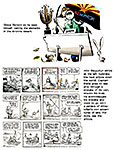
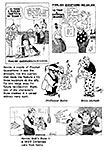
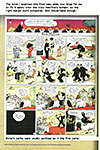
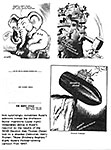
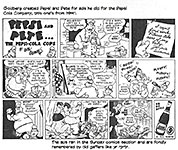
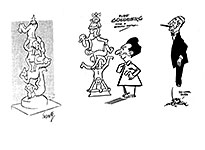
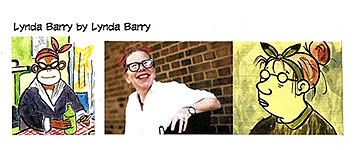
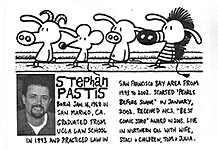
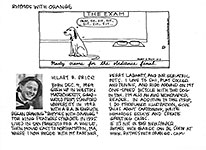
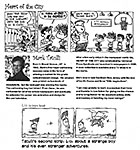
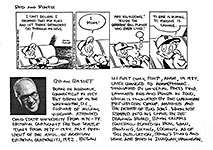
1.jpg)
2.jpg)
3.jpg)
4.jpg)
5.jpg)
6.jpg)
7.jpg)
8.jpg)

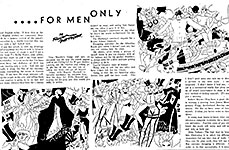
9.jpg)
10.jpg)
11.jpg)
12.jpg)
13.jpg)
14.jpg)
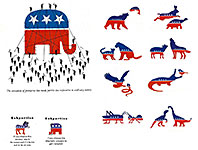
15.jpg)
16.jpg)
17.jpg)
18.jpg)
